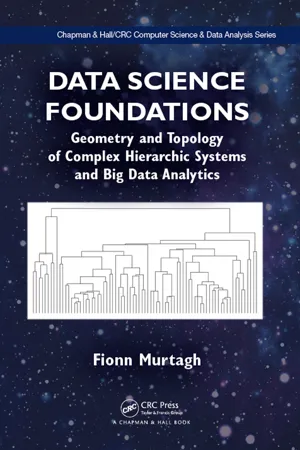![]()
Part 2
Foundations of Analytics through the Geometry and Topology of Complex Systems
![]()
3
Symmetry in Data Mining and Analysis through Hierarchy
3.1 Analytics as the Discovery of Hierarchical Symmetries in Data
In this chapter, we have data analytics as the discovery of symmetries in data. This well addresses our contemporary big data needs, especially because symmetries can be at different resolution scales. That is to say, we may consider the overall and general issues either observed or confronting us. We may also consider the specific issues in detail. Resolution scale is nicely expressed as hierarchy. A chapter in an important book by 1978 Nobel Prize winner, Herbert Simon [219], has the appropriate chapter title “The architecture of complexity: hierarchic systems”.
Hierarchy provides a unifying view of patterns, in the context of data mining and data analysis. We consider how hierarchy fully fulfils the role of determining data symmetries.
Symmetry plays a fundamental role in theoretical physics and in many other domains like art and design. Group theory is the way that mathematics views symmetries. Here we describe the various ways that hierarchy, and related data analysis and data handling, express symmetries in data. This provides a good background for later discussion, and in particular in Part IV.
Data analysis and data mining are concerned with unsupervised pattern finding and structure determination in data sets. The data sets themselves are explicitly linked as a form of representation to an observational or otherwise empirical domain of interest. “Structure” has long been understood as symmetry which can take many forms with respect to any transformation, including point, translational, rotational, and many others. Symmetries directly point to invariants, which pinpoint intrinsic properties of the data and of the background empirical domain of interest. As our data models change, so too do our perspectives on analysing data. The structures in data surveyed here are based on hierarchy, represented as p-adic numbers or an ultrametric topology.
3.2 Introduction to Hierarchical Clustering, p-Adic and m-Adic Numbers
Herbert A. Simon, Nobel Laureate in Economics, originator of “bounded rationality” and of “satisficing”, believed in hierarchy at the basis of the human and social sciences, as the following quotation shows: “my central theme is that complexity frequently takes the form of hierarchy and that hierarchic systems have some common properties independent of their specific content. Hierarchy, I shall argue, is one of the central structural schemes that the architect of complexity uses” [219, p. 184].
Partitioning a set of observations [225, 226, 157] leads to some very simple symmetries.
This is one approach to clustering and data mining. But such approaches, often based on optimization, are really not of direct interest to us here. Instead we will pursue the theme pointed to by Simon, namely that the notion of hierarchy is fundamental for interpreting data and the complex reality which the data expresses. Our work is very different too from the marvellous view of the development of mathematical group theory – but viewed in its own right as a complex, evolving system – presented by Foote [78].
3.2.1 Structure in Observed or Measured Data
Weyl [243] makes the case for the fundamental importance of symmetry in science, engineering, architecture, art and other areas. As a “guiding principle”, “[w]henever you have to do with a structure-endowed entity … try to determine its group of automorphisms, the group of those elementwise transformations which leave all structural relations undisturbed. You can expect to gain a deep insight in the constitution of [the structure-endowed...
